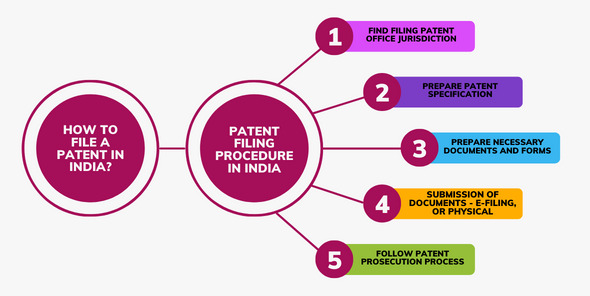Welcome to the official blog of the Law Offices of Kr. Vivek Tanwar Advocate and Associates, where we are dedicated to providing litigation support services for matters related to Patent Application Process. In today’s blog post, we aim to shed light on the prevailing issues regarding Patent Application Process, and the steps we can take as a society to combat these acts. Join us as we explore this critical subject and empower you with the knowledge to protect your rights and safety.
Introduction:
Securing a patent for your innovative idea is a critical step in protecting your intellectual property. The patent application process involves several stages, each demanding attention to detail and adherence to specific timelines. In this article, we will guide you through the complete patent application process, shed light on the timeline for approval and registration, and explain the steps involved in enforcing patent rights in court in case of infringement.
There are three types of patents: utility, design and plant. Utility and plant patent applications can be provisional and nonprovisional. Provisional applications may not be filed for design inventions.
The Patent Application Process:
1. Conduct a Thorough Patent Search:
Before diving into the application process, it’s crucial to ensure that your invention is unique. Conduct a thorough patent search to identify similar inventions and assess the patentability of your idea.
2. Prepare and Draft a Patent Application:
Work with a qualified patent attorney or agent to prepare a comprehensive patent application. This document should include detailed descriptions, drawings, and claims that clearly define the novelty and inventiveness of your idea.
3. File the Patent Application:
Submit your application to the relevant patent office. The filing process includes paying the necessary fees, which may vary based on the type of patent and the jurisdiction.
4. Patent Examination:
Once filed, your application undergoes a thorough examination by patent examiners. This stage involves assessing the patent’s novelty, non-obviousness, and utility. You may need to respond to office actions and provide additional information during this phase.
5. Publication:
After a successful examination, your patent application is published. This disclosure allows the public to access information about your invention, contributing to the overall body of knowledge in your field.
6. Grant and Registration:
If your application passes all examinations and meets the patent office’s criteria, a patent will be granted. Following the grant, you need to complete the registration process, which may involve paying additional fees.
Timeline for Approval and Registration:
Getting a patent can take two or three years after you file your application. This process, which is known as patent prosecution, may become longer and more complicated if your patent faces opposition, or if the U.S. Patent and Trademark Office (USPTO) asks for more information. The timeline for the patent application process varies, but it typically takes several years from filing to grant. Factors influencing the timeline include the complexity of the invention, the backlog of applications at the patent office, and any challenges faced during examination.
Enforcing Patent Rights in Court:
1. Monitor and Detect Infringement:
Regularly monitor the market for potential infringement of your patented invention. This may involve keeping an eye on competitors, conducting market research, and utilizing intellectual property monitoring services.
2. Cease and Desist Letter:
If infringement is detected, the first step is often to send a cease and desist letter to the alleged infringer. This letter outlines the patent owner’s rights, demands the cessation of infringing activities, and may include the option for negotiation or licensing.
3. Alternative Dispute Resolution (ADR):
Before heading to court, consider alternative dispute resolution methods such as mediation or arbitration. These approaches can be more cost-effective and faster than traditional litigation.
4. Filing a Lawsuit:
If informal methods fail, filing a lawsuit in a federal court is the next step. The patent owner must prove the validity of the patent and demonstrate how the alleged infringer’s activities violate their rights.
5. Court Proceedings and Remedies:
Court proceedings may involve discovery, expert testimony, and legal arguments. If infringement is proven, the court may grant remedies such as injunctions to stop the infringing activities and monetary damages to compensate the patent owner for losses.
6. Appeals and Enforcement:
Both parties have the right to appeal court decisions. If successful, the patent owner can enforce the court’s judgment and seek further remedies if necessary.
Conclusion:
Securing a patent involves a comprehensive and often lengthy process. From the initial application to the enforcement of patent rights in court, each step is crucial in protecting your intellectual property. By understanding and navigating this process, innovators can safeguard their inventions and contribute to the advancement of technology and knowledge.
We are a law firm in the name and style of Law Offices of Kr. Vivek Tanwar Advocate and Associates at Gurugram and Rewari. We are providing litigation support services related to law matters in India, please do not hesitate to contact us. We are here to provide you with expert legal counsel and representation tailored to your specific needs and concerns.
Written by: Divya Yadav


The free blood pressure check is a nice touch.
how can i get cheap lisinopril without rx
Their international shipment tracking system is top-notch.
Their cross-border services are unmatched.
order lisinopril online
Some trends of drugs.
Consistent service, irrespective of borders.
where to buy clomid without insurance
The staff always remembers my name; it feels personal.
A pharmacy that prioritizes global health.
cost of cipro without dr prescription
This pharmacy has a wonderful community feel.
Excellent consultation with clear communication.
tramadol and gabapentin together for dogs
Always professional, whether dealing domestically or internationally.